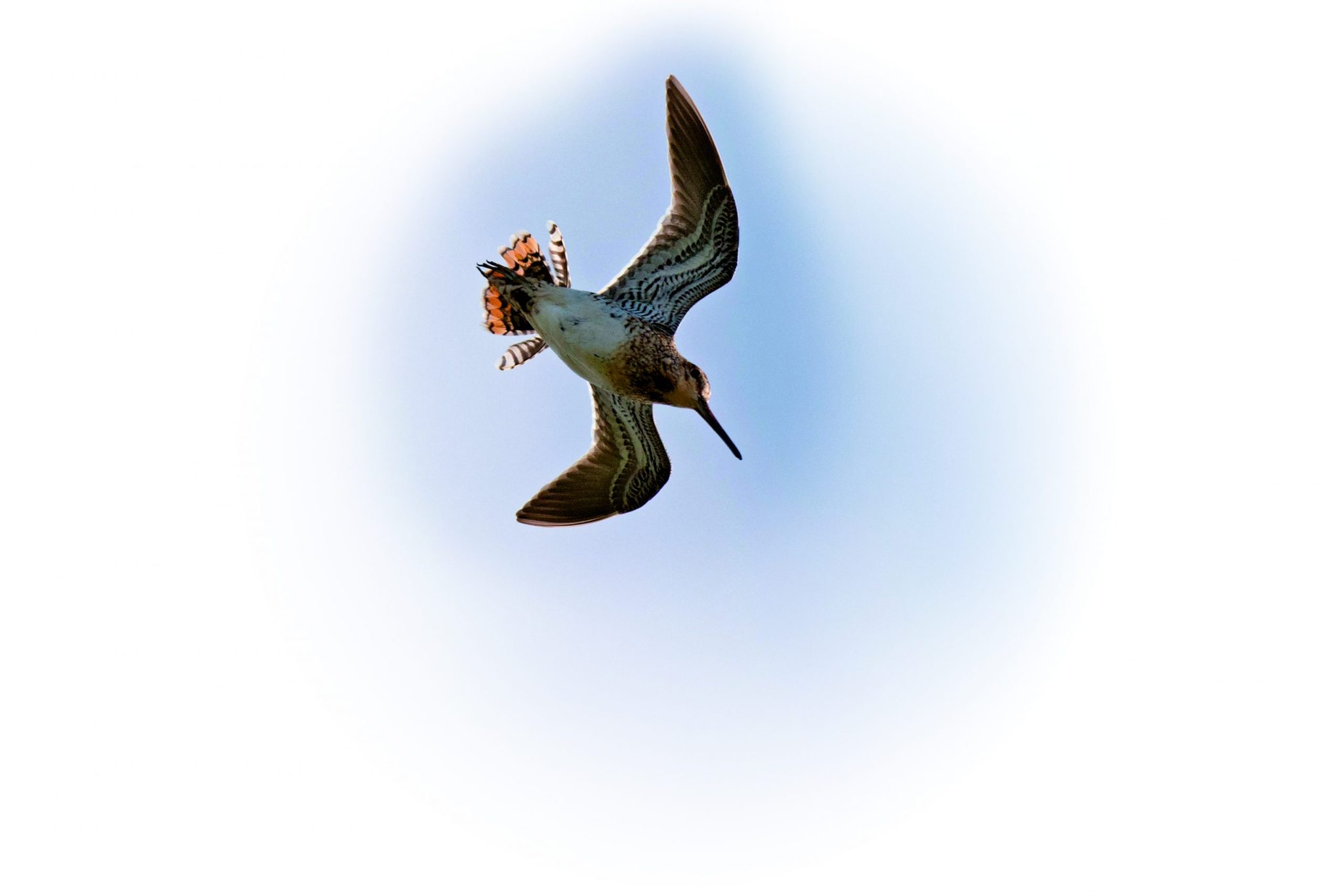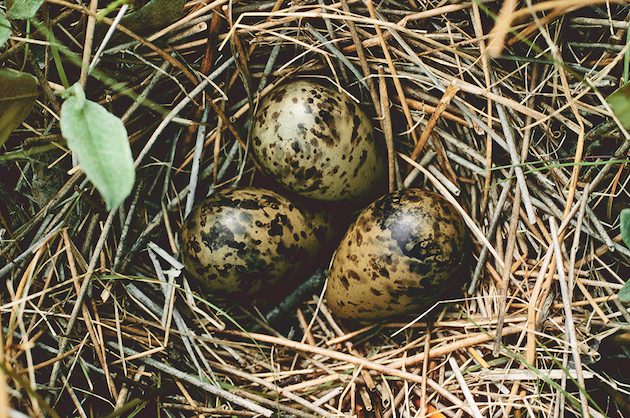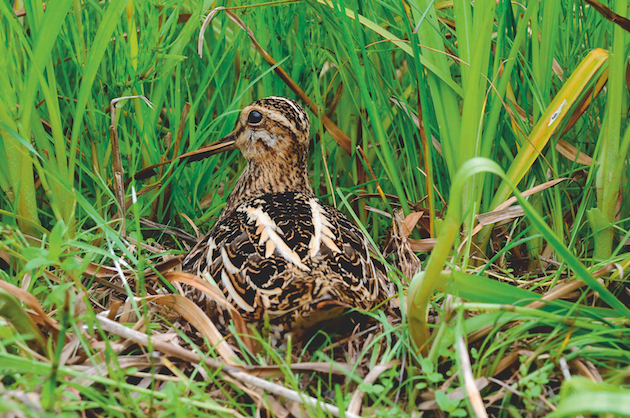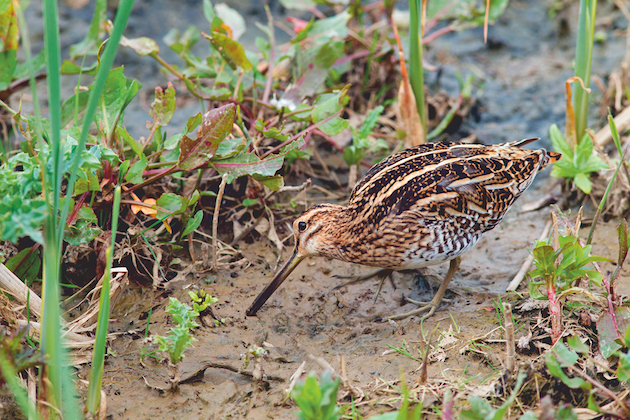Win CENS ProFlex DX5 earplugs worth £1,149 – enter here
The common snipe – or, as the Finnish call it, the ‘sky ram’

Facts about the common snipe
- Distribution: Most worldwide populations of snipe are highly migratory, breeding in Iceland and across much of Europe, Russia and northern Asia. Overwinters in Africa and southern Asia.UK distribution: British populations are largely resident or only partially migratory. Can be found across the country but more numerous in the north and Ireland.
- IUCN Red list status : Least Concern, though decreasing globally
- Habitat: Prefers wetland and flooded cultivated areas. Breeds in moorland and rough pastures in upland areas.
- Food: Mainly insects, earthworms and small crustaceans; some plant matter.
- Breeding: Pairing takes place after aerobatic display flights.
- Nesting: The nest is little more than a depression in the ground lined with grasses, located in a well-hidden location. Only the female incubates the eggs, which hatch after about 20 days. Both parents look after the brood, taking responsibility for half each. The young fledge around 20 days.
- Clutch size: Normally four eggs
- Incubation time: 18–21 days
- Length: (average) 25–27cm
- Wingspan: (average) 44–47cm
- Weight: (average) 80–140g
- Lifespan: (average) Normally 3-6 years
- Flight speed: Up to 60 mph
- Shooting season: England, Wales & Scotland: 12 August–31 January. Northern Ireland: 1 September–31 January
A diminutive wading bird
Robert Burns called the common snipe “the blitter frae the boggie”, and the noise that this diminutive wader makes in flight echoes in many other local names in Scotland and Ireland including blutter or heather bleater or bog bleater.
A little further afield and you will find that the Finnish name translates as sky ram. It does indeed resemble the bleating of a goat but in fact the sound is not a call. As part of its courtship display the bird flies in wide circles and then dives, sometimes almost vertically, with its tail feathers fanned out to vibrate and create this extraordinary sound, which is more often described as drumming, even though it does not really resemble a drum that much. You are most likely to hear it at dawn or dusk during spring and early summer when the birds are marking territory or displaying to potential mates, but snipe can drum at any time of year. The mystery of how this unusual sound is made was once the subject of long debate until proven by zoologist Philip Manson-Bahr, who whirled two snipe tail feathers, attached to a cork, around his head on a piece of string to recreate it.
Dapper bird
The common snipe is a small and somewhat stocky bird, which, at a distance, appears to be a dull brown. Look closer, though: its body patterning of gold and black with prominent cream stripes down the back, along with the striped gold and brown head, give it a very dapper appearance as well as providing excellent camouflage against the surrounding cover of the wet feeding areas that this shy bird prefers.
Shooters need to take care to distinguish between it and its much smaller cousin the jack snipe, a winter visitor half the size, which appears rather darker and has a shorter bill. Far less willing to flush than its common relative, the jack snipe tends not to fly so high nor far before dropping to cover again and has a less erratic flight. The jack snipe does not breed in Britain and is a winter visitor, which may only be shot in Northern Ireland.
The strikingly long, probing bill is used to search mud and soft ground for the insects and other small creatures on which they feed. The tip is covered with nerve endings that detect prey, which is grasped thanks to a special ability to open the end quarter of the bill while keeping the rest closed. With eyes set far back in the head, the snipe is still able to see when it is feeding. Indeed, the name comes from the Old English ‘snite’, which means a long, thin object. The shape of the head gives the impression of pointing at a specific object and may well have given rise to the modern term ‘sniping’ or singling someone out for personal criticism. Alternately, the difficulty involved in shooting a snipe may also be an origin from the difficulty of hitting such a difficult target. The old expression ‘to send someone on a snipe hunt’ means committing them to an extremely difficult or impossible task, rather like a wild goose chase.
Prized
Certainly, a great many more snipe are shot at rather than are actually hit. Although some shoots are fortunate enough to have their own snipe bogs, most are encountered by the rough shooter, as an occasional surprise on a formal day, or coming over the August grouse butts when they may be the only other game species also in season.
Their speed alone makes them a difficult enough target, added to which the flight throws in frequent random and rapid jinking. This pattern has often been ruefully considered a special adaptation to avoid a charge of shot, though it is really to avoid aerial predators. Snipe will often feed in small groups of just four or five, rising together like flickering ghosts when disturbed; the collective noun of wisp is one of the most apt for any bird.
The snipe may be a small bird that only provides a few mouthfuls, but it is without doubt a prize well worth preparing for the table. Once they were netted in large numbers and records from the 16th century set the going rate as thruppence for a dozen. Today you’ll need to shoot your own, though. The traditional way to prepare snipe for roasting is plucked and layered in fatty bacon to prevent the breast meat from drying out, with the head twisted round to use the beak as a skewer. Many gourmets insist that the innards should be left in place, and that the bird is placed on a piece of toast in the roasting dish to soak up the juices created by cooking.
Related Articles
Get the latest news delivered direct to your door
Subscribe to Shooting Times & Country
Discover the ultimate companion for field sports enthusiasts with Shooting Times & Country Magazine, the UK’s leading weekly publication that has been at the forefront of shooting culture since 1882. Subscribers gain access to expert tips, comprehensive gear reviews, seasonal advice and a vibrant community of like-minded shooters.
Save on shop price when you subscribe with weekly issues featuring in-depth articles on gundog training, exclusive member offers and access to the digital back issue library. A Shooting Times & Country subscription is more than a magazine, don’t just read about the countryside; immerse yourself in its most authoritative and engaging publication.










